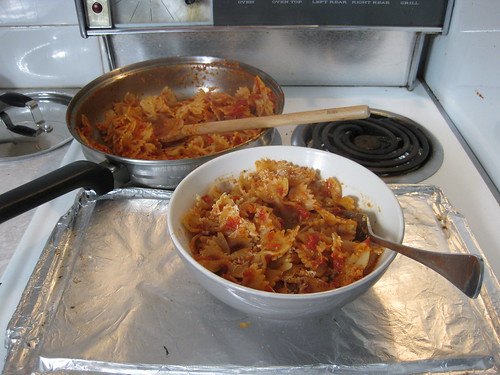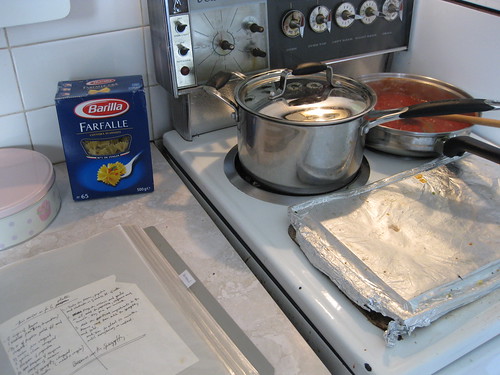
I have recently been enjoying the perks of being unemployed during the uni break. These perks include such things as spending a straight five hours knitting, wearing pyjamas to approximately three pm and cooking indulgent lunches. This is one of those lunches. It’s a recipe that I’ve been making for a few years now. The best thing about it is that it doesn’t entail any onion chopping (who wants to cry at lunch time anyway?) It’s also super quick and cheap to make. There is no real set in stone recipe here, I tend to just chuck everything together. Nothing horrible should go wrong, however make sure to taste test it every now and then to check that you’re on the right track.

Garlic and Tomato Pasta.
Ingredients:
- pasta
- a few garlic cloves (2)
- a can of tomatoes
- tomato paste
- salt, pepper, basil
- parmesan cheese
1. Get some water on the boil and cook your pasta. Doesn’t really matter what sort. I usually use plain old spaghetti but today I used farfalle (bows) and it turned out great. My favourite brand of dried pasta is Barilla with the blue packaging.
2. Put a pan on the heat with enough oil to just cover the bottom. When this is hot chuck in some crushed garlic cloves. I used two fairly large ones but it all depends on how much you like garlic. Turn the heat down a bit so that the garlic doesn’t burn.
3. Quickly, quickly, while the garlic is heating up, open a can of tomatoes. I use whole tomatoes and spend this time cutting them up and getting rid of the hard end pieces. However, if you were feeling particularly lazy I guess you could used a can of crushed.
4. When the garlic has been on for a while (before it turns brown!) add a few spoonfuls of tomato paste (around 1 tablespoon, I used two soup spoons.) Stir this around a bit and then add the whole can of tomatoes, including sauce.
5. Add some salt and pepper to taste. I also add some dried basil and maybe oregano. If using fresh herbs, add them at the end when the pasta is done.
6. Let the sauce simmer for a while, stirring occasionally. I just let it sit on the stove top until the pasta is done.
7. When the pasta is cooked, drain it, add a few drops of oil to it and stir it into the sauce in the pan.
8. Cover and let sit until you can’t stand it any more (a few minutes will do.) To fill the time, grate some yummy parmesan cheese.
9. Put the pasta into bowls, sprinkle on cheese, and you’ve done it, stud!










